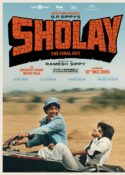 Director Manish Gupta reflects on his film The Stoneman Murders with Subhash K Jha.
Director Manish Gupta reflects on his film The Stoneman Murders with Subhash K Jha.
In the era when mobile phones weren’t even dreamt of, characters in our films connected on landlines or not at all. Into this world of conditional connectivity crept a collage of crimes and confusion only because punishment, justice, and retribution were not linked closely enough. In The Stoneman Murders, writer-director Manish Gupta and co-producers Sheetal Talwar and Bobby Bedi take us into the anarchy of an era when technology was tenuous, and crime meant smuggling and racketeering rather than extortion and terrorism.
Serial killing is still an alien crime in India. The phenomenon made a rare appearance on our streets in the mid-1980s when an unidentified wacko went around bashing in the faces of sleeping pavement dwellers in the dead of night with a rock.
India’s first certifiable rock star from hell? It’s a gruesome subject for a film. The Stoneman Murders does nothing to redeem the sense of claustrophobic dread that shrouds the characters on either side of the law. The moments created to establish a link between the private life and public investigations of the cops are so stagey you wonder if they were written and shot to deliberately deflect attention from the main business at hand, namely the messy killings.
Let’s face it. The mind of a serial killer is beyond our comprehension. As facts have it, The Stoneman Murders remain unsolved in our police files. This is where the film’s plot gets inventive. It seeks out a neat end to the messy murders involving intrigue and Satanism within the police force. The shock value is applied with jolting generosity at the climax. But the suspense element in most of the narrative is depleted by the restricted space in which the characters manoeuvre their motivations.
The enormity of the multiple-murder crimes is quite often restricted to showing pictures from the newspapers or glimpses of sprawled bodies on pavements. By the time Kay Kay Menon, as gritty and honest on camera as ever, cracks the case, our patience with this dark, gloomy chronicle of the grisly goings-on has run thin. Even the cop-and-criminal chases in dimly lit subways and railway stations fail to get our adrenaline running.
The pit is reached in the scenes between the suspended cop Kay Kay and his screen wife (Rukhsar), whose exchanges are more like a radio skit than a film in which marital discord is a vital clue to the murderous plot.
Kay Kay Menon’s strong, wry, unsmiling presence brings grit to the feeble drama. Arbaaz Khan, his adversary in the police department, has nothing much to do. A couple of supporting performances try to flesh out the shadowy scenario. The periodicity (the 1980s) is established through common devices like songs and films. At one point, a prostitute calls out to our hero, addressing him as “Rajesh Khanna.”
Manish Gupta relives the horror.
The Stoneman Murders is now not-so-sweet 16?
Seems like a lifetime ago, one and a half decades have passed since my debut directorial ‘ The Stoneman Murders’ released on this day sixteen years ago. This particular day was chosen for the release by producer Bobby Bedi because it was a Friday the 13th!
Is this the Bobby Bedi who produced Bandit Queen?
Yes, working with Bobby Bedi was a dream come true. I was in my early thirties and fresh out of the success of ‘Sarkar’ (which I wrote) and Darna Zaroori Hai (of which one story I directed). Bobby Bedi had loved my script and he’d signed me immediately as the Director-Writer of the film.
The individual producer no longer exists?
That’s right. Back then, there used to be individual producers investing their own money to back a director’s vision. Today, to make a Hindi film, you mostly need approval from a Studio – which has become a very complicated procedure and, therefore, disastrous to the creative vision of a director. Sixteen years ago, the scenario was different.
The Stoneman Murders got its due share of marketing?
The individual producers back then were the owners of the film and, hence, put their blood and sweat into it. Hence, the film was publicized very well, and neon signs showing the ‘Stoneman’ in a hood were put up all over the metros. The film did well in the theatres, and over the years, thanks to streaming on the OTT platform Amazon Prime, it has now become a cult classic.
There was a very obtrusive item song that brought rot to the taut.
The only regret I have about The Stoneman Murders is that I’d put an ‘Item Song’ upon the insistence of the producer Bobby Bedi, who opined that it is necessary for the entertainment of the audience. But the opposite happened. The audience in theatres was shocked and disappointed when the item song started. They felt that the item song was completely out of place in an otherwise realistic, gritty, edge-of-the-seat thriller film. Even today, when the film is playing on TV, and I happen to see it, I feel like hiding under my bed in embarrassment due to that cringy item song which I am ashamed of shooting. However, this was a huge learning for me. Thereafter, I decided to stick very strictly to my own vision for a film and not to entertain any input from other parties, be it the producer, studio head, or actors – because, ultimately, the onus of the film’s success rests on me.
How did you get the idea to make The Stoneman Murders?
I’d got the idea for The Stoneman Murders when I read an article about a serial killer in the 80s who stalked Bombay killing pavement dwellers by crushing their heads with a large stone. That time, internet was not so powerful. So my team and I went to the Times of India archives and dug out old articles about the film, based on which I wrote the film. These same articles are shown in the opening titles of the film. Since the ‘Stoneman’ was never caught and his identity remains unknown to this day, there was not much info about who he was and his probable motives. So, I had to rely a lot on my own imagination to write the script.
Your favourite sequence in the film?
There’s a sequence of Kay Kay Menon chasing the hooded killer inside the Sion subway; this scene remains one of the best scenes I’ve ever filmed. I cast Kay Kay Menon because I had worked with him on Sarkar for which I’d written the screenplay and dialogues.










